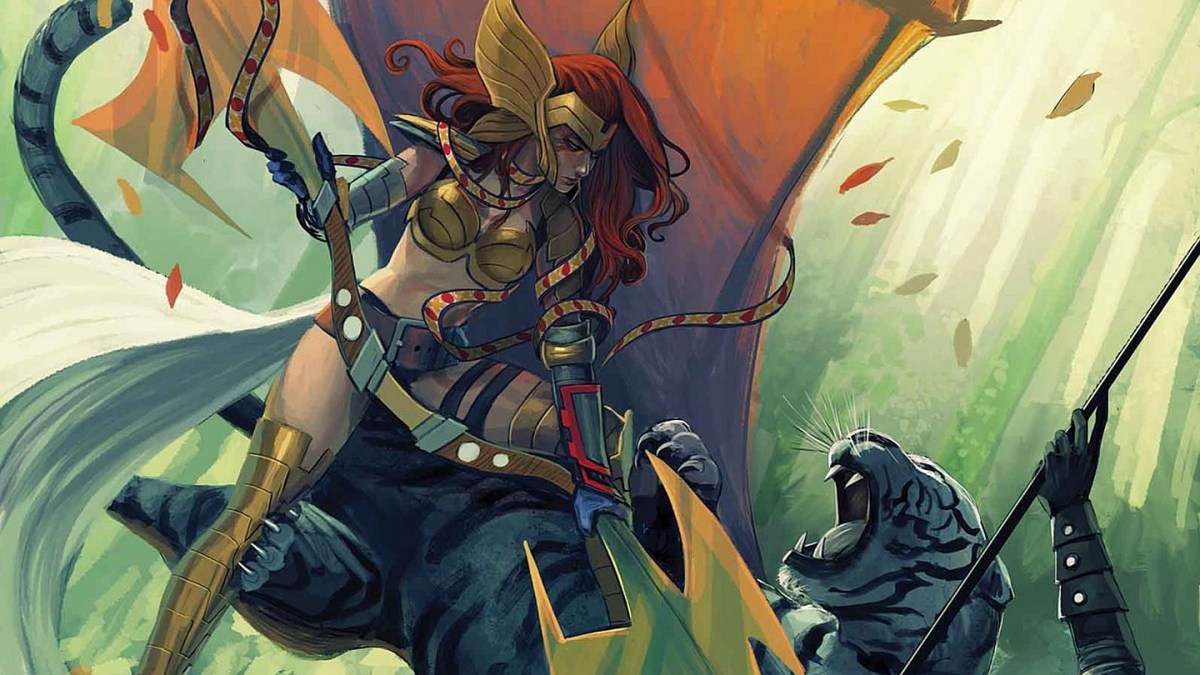Check out our review of Angela: Asgard’s Assassin #1 right here!
With five issues under its belt and its first arc nearly complete, Angela: Asgard’s Assassin continues to be a standout comic book series on every level in terms of artwork, character, and story.
Phil Jimenez and Stephanie Hans’ illustrations are gorgeous. Their character designs strike the perfect balance between cartoon and realism and they use a variety of angles and panel arrangements to great effect without coming off as self-indulgent. Romulo Fajardo’s color work (an oft underappreciated job, I suspect), is truly spectacular, blending tones together, particularly in the flashbacks, to create a sense of texture and depth reminiscent of an Amy Brown painting (and I mean that in a good way).
Angela herself continues to be a compelling character, though the further into A:AA I go, the more apparent it becomes that she needs an ensemble cast to carry the series. This isn’t a criticism against Angela, so much as a tip of the hat to writers, Kieron Gillen and Marguerite Bennett, for understanding what their heroine needs to flourish. To be very clear, Angela is not a dull or one-note character, but she’s stoic, and that can only go so far on its own. It’s her contrast to other characters that keeps her from stagnating. Her seriousness clashes well against Star Lord and Rocket’s snarkiness and her relationship with Sera (a fantastic transgender character, by the way) brings out what little tenderness she has. Though technically a solo series, Angela: Asgard’s Assassin is a group effort, and with all the loners out there headlining comic books, that’s a good thing.
The plot is, really, A:AA’s only stumbling block. I stand by my introductory paragraph that A:AA is a triumph on every level, but out of artwork, character and story, story is last and least. Angela’s journey across realms with the kidnapped heir of Asgard is engrossing and character driven, but it feels improvised, as though Gillen was just making the rules up as he went. Reading issues #2-5, I imagined myself engaged in a telepathic conversation with him.
Gillen: So, Angela steals Freyja and Odin’s baby-
Me: Hold on, what baby?
Gillen: Remember when Freyja got pregnant?
Me: No.
Gillen: At the end of Everything Burns?
Me: (Goes back and re-reads) Oh, okay.
Gillen: So-
Me: Wait, has she been gestating all this time? Nobody mentioned that when Thor lost Mjolnir and we all thought she was Lady Thor for an issue.
Gillen: Yes well… we’re hoping character consolidation after Secret Wars improves our continuity. May I continue?
Me: Fine.
Gillen: So, it turns out that Odin and Freyja conceived their daughter in the space between spaces. And you know what that means?
Me: …
Gillen: It’s a DEMON BABY!
Me: …
Me: Okie dokie, then.
To A:AA’s credit, it does make the plot work. When the new rules are established, I’m more than happy to go along with them, largely because the story’s execution and the characters make the journey worthwhile and, hey, I want to know what happens to the nameless Demon!Baby. If you haven’t picked up A:AA, I strongly recommend it. But, you know, you might want to hurry.
Petra Halbur is an undergraduate at Hofstra University pursuing a BA in journalism and presently trapped in the world-building phase of writing her science-fantasy novel. You can read more from her at Ponderings of a Cinephile or follow her on Twitter.
Are you following The Mary Sue on Twitter, Facebook, Tumblr, Pinterest, & Google +?









Published: Apr 15, 2015 12:20 pm